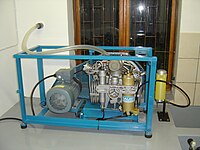
Photo from wikipedia
INTRODUCTION Pneumatic compression therapy is one of several options for the management of lymphedema. The lack of clarity around clinical outcomes, quality of life, cost of care, and its proper… Click to show full abstract
INTRODUCTION Pneumatic compression therapy is one of several options for the management of lymphedema. The lack of clarity around clinical outcomes, quality of life, cost of care, and its proper application as a function of lymphedema complexity limit its use in clinical practice. This is compounded by difficulties associated with insurance approval and uncertainty about the role of this modality in the treatment algorithm. The purpose of this study is to elucidate the healthcare economics and value of pneumatic compression therapy for lymphedema. METHODS All patients who underwent treatment for lymphedema at a single institution were followed prospectively over a two-year period. Patient demographics, comorbidities, treatment modality, and treatment efficacy were determined. Direct costs over the two-year period, inclusive of hospitalization and device costs, SF-36 quality of life, and leg lymphedema complexity score (LLCS) were measured. RESULTS 128 patients were enrolled over a three-year period for a total of 232 extremities treated for secondary lymphedema. Pneumatic compression therapy was utilized for all patients and led to a 28% decrease in absolute limb volume (P < 0.001), decrease in body-mass index (BMI) (P < 0.001), significant improvement in SF-36 quality of life in 7 out of 8 domains (P < 0.001), and a significant improvement in LLCS (P < 0.001) at one year. A subsequent decrease in hospitalization for lymphedema-associated complications saved over $3,200 per patient per year. CONCLUSION Pneumatic compression therapy leads to improved clinical outcomes, quality of life, and functional status for clinically-significant lymphedema. Significant per capita direct cost savings, a beneficial impact on pay for performance measures, and a reduction in lymphedema-related complications suggest that earlier adoption of this treatment modality may offer a superior value proposition to patients, physicians, hospitals, and the healthcare system.
Journal Title: Annals of vascular surgery
Year Published: 2019
Link to full text (if available)
Share on Social Media: Sign Up to like & get
recommendations!